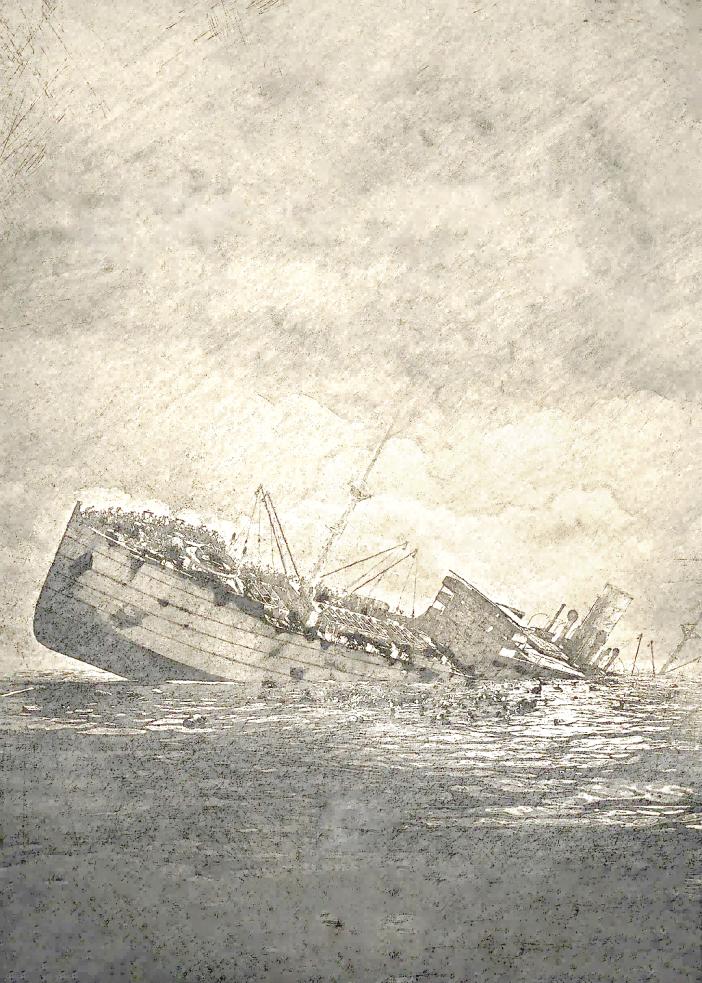
The filming site of the documentary "The Sinking of the Lisbon Maru."
My first encounter with the the "Lisbon Maru" occurred in 2014. While on a marine expedition, I happened to learn that the wreck of the ship had never been precisely located. With a background in geophysics and extensive experience in marine exploration, I was immediately drawn to the challenge.
As I delved deeper into the research, I began to uncover the harrowing history behind the vessel.
In October 1942, the Japanese army requisitioned the cargo vessel "Lisbon Maru" to carry more than 1,800 British prisoners of war (POWs) from Hong Kong to Japan. In violation of international conventions, the Japanese army did not put any markings on the ship to indicate the POWs inside.
Torpedoed by the U.S. army, the vessel sank in the waters off the Zhoushan Islands in east China's Zhejiang province. As the ship went down, many British POWs who leapt into the sea were fired upon by Japanese guards. In stark contrast, local Chinese fishermen risked their lives to mount a daring rescue. After 25 agonizing hours, the "Lisbon Maru" finally disappeared beneath the waves.
As my investigation concluded, I felt the lost lives aboard the ship were silent histories awaiting witness. This conviction drove me to produce the documentary "The Sinking of the Lisbon Maru."

Descendants of British prisoners of war (POWs) meet with Lin Agen (front row, far right) and descendants of Chinese fishermen.
To reconstruct the events aboard the ship, we published notices in British newspapers such as The Times, The Telegraph, and The Guardian. Eventually, we connected with over 380 descendants of those involved, gathered more than 10,000 historical photographs, and conducted in-depth interviews with over 130 individuals, including three survivors - Private Dennis Morley of the Royal Scots, Private William Beningfield of the Middlesex Regiment, and Chinese fisherman Lin Agen, one of the rescuers.
Morley recounted with trembling hands and haunted eyes: "Without the Chinese intervention, we'd all have perished under Japanese machine gun fire.
He believed the rescuers never truly knew how many lives they had saved. His daughter, Denise Viney, was deeply moved: "Those Chinese fishermen were heroes. If they hadn't come, my father wouldn't have survived, and I wouldn't be here today."
Amid the chaos of sinking wreckage and relentless gunfire, the Chinese fishermen launched 46 boats, making 65 trips to rescue 384 British POWs. Among them was 17-year-old Lin Agen, who, together with fellow villagers, rowed a small wooden boat back and forth from dawn until midday, ultimately saving eight men.

Reconstruction scene depicting the sinking of the "Lisbon Maru"
"I was swimming toward the island, wondering how I'd climb the rocks," recalled Beningfield, tears welling in his eyes. "Then I saw a small boat approaching. I am forever grateful to the Chinese fishermen. They risked everything to save us, even though the Japanese could have retaliated against their entire village."
Tragically, all three survivors passed away before the documentary's release. But we were fortunate to preserve their testimonies while they were still alive, ensuring that this overlooked chapter of history could be brought to light.
The documentary also explores a deeper question of human nature: How do people make moral choices under extreme circumstances? Are such decisions shaped by hardship, culture, or conscience?
The Chinese fishermen answered with quiet conviction. When they saw the soaked, half-naked British POWs, they offered clothes, hot water, and food. Though their island was impoverished and farmland scarce, they gave all they could. To Lin and many of the fishermen's descendants, their actions were simply what any decent person would do.
Their compassion and courage - offered freely, without regard for personal safety - continue to resonate across time and borders. When Lin passed away in 2020, many descendants of the British POWs sent heartfelt condolences. One message read: "He leaves behind a legacy of courage, heroism, and kindness in the face of the darkest acts of war."
This year marks the 80th anniversary of the Chinese People's War of Resistance against Japanese Aggression and the World Anti-Fascist War. The "Lisbon Maru" story carries renewed relevance. It is not just a part of Chinese or British history - it is part of our shared human memory. Documenting it was a global endeavor.
British historian Tony Banham was the first to research this neglected episode. His book The Sinking of the Lisbon Maru: Britain's Forgotten Wartime Tragedy provided invaluable material for the documentary. As a filmmaker, I took up the second baton, transforming those records into a visual narrative. Now, the third baton passes to viewers worldwide. Their reflections on war, morality, and compassion help sustain a shared resonance - one that can inspire greater unity in the pursuit of peace.
The story of the Chinese fishermen and the British POWs is a vivid embodiment of a community with a shared future for mankind. Even in moments of profound danger, compassion can transcend borders. People of different nations can come together, offering each other hope, dignity, and the will to survive.
(Photos provided by Fang Li)
Fang Li is the producer and director of the documentary "The Sinking of the Lisbon Maru." This article was compiled by People's Daily journalist Li Xinyi upon an interview with Fang.
(Web editor: Zhong Wenxing, Du Mingming)
 Editor:Qiu Xiaochen
Editor:Qiu Xiaochen| 前面有个豹子是什么车 | 杨贵妃属什么生肖 | 牙胶是什么 | 步兵是什么意思 | 右肩膀疼痛预示什么病 |
| 什么卫什么海 | 甲状腺结节看什么科 | 为什么冬吃萝卜夏吃姜 | 女生纹身什么图案好看 | 腰酸背痛是什么原因 |
| 木耳菜不能和什么一起吃 | 十月十一日是什么星座 | 荼靡是什么意思 | 面目狰狞是什么意思 | 腰扭伤吃什么药最有效 |
| 低密度脂蛋白偏高吃什么食物 | 2.8是什么星座 | 什么是华盖 | 左侧卵巢囊性包块是什么意思 | 牡蛎和生蚝有什么区别 |
| 阴囊潮湿吃什么药好hcv9jop0ns4r.cn | 什么叫做脂肪肝hcv8jop4ns7r.cn | 火彩是什么hcv9jop1ns4r.cn | 吃大虾不能吃什么hcv9jop2ns1r.cn | 小孩晚上睡觉磨牙是什么原因hcv8jop7ns1r.cn |
| 日有所思夜有所梦是什么意思hcv8jop3ns1r.cn | 手指脱皮是什么原因造成的hcv9jop4ns8r.cn | 大三阳是什么病hcv8jop7ns9r.cn | 曲水流觞是什么意思hcv7jop6ns3r.cn | 防晒霜什么牌子好gysmod.com |
| 石花菜是什么植物yanzhenzixun.com | 健身有什么好处hcv8jop7ns3r.cn | dr钻戒什么档次hcv9jop0ns5r.cn | 子非鱼什么意思hcv8jop5ns9r.cn | 被是什么偏旁怎么读hcv8jop0ns0r.cn |
| 为什么一吃饭就胃疼hcv9jop0ns5r.cn | 中耳炎是什么症状hcv9jop2ns1r.cn | 涧什么字hcv8jop3ns9r.cn | 膝盖疼吃什么药hcv9jop5ns2r.cn | 木耳不能和什么食物一起吃wuhaiwuya.com |